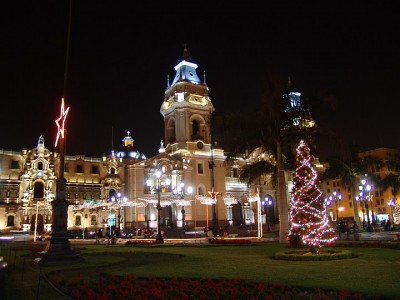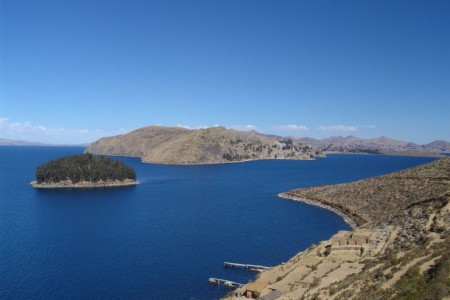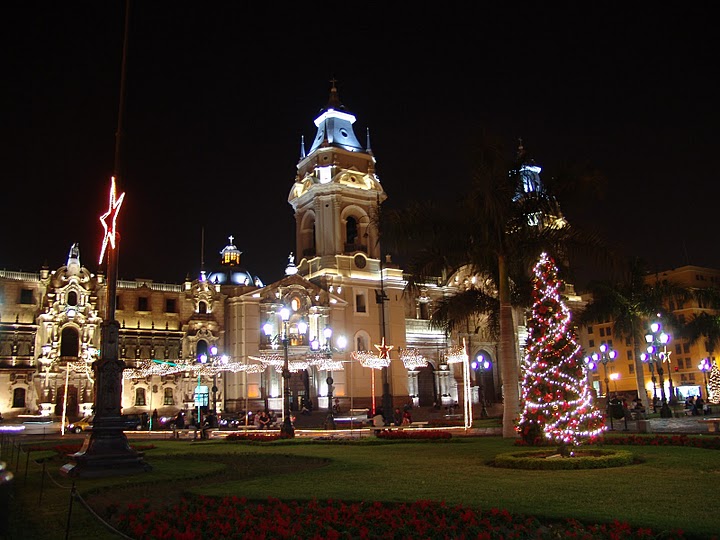

Lima
First stop, Lima! Capital of Peru and largest city. To be honest I’m going to be lazy about Lima since there is a free Lima tour offered by Lucid Lima (http://www.lucidlimafreetour.com/), I’ll just take this tour to see what the city has to offer and go from there. I guess sometimes it’s not to just go ot a city and not knowing what to see and discover it by yourself. The tour will give me a good start and let me meet some other travelers so we can exchange ideas and tips. Besides the free walking tour, they actually offer a pub crawl where they organise nightlife tour with bars and partying with various people. You get great discounts and free shots for a fixed price. Another great initiative from Lucid Lima in my opinion. (http://www.lucidlimapubcrawl.com/)
Food & drinks
Before I continue the route, I wanna mention the food and drinks in Peru. Ceviche is surely number one on the list of dishes I must get to know, not only because it happens to be the “Peruvian national dish“, but because of its unparalelled delicious taste. With the increasing interest in the Peruvian cuisine, ceviche is quickly making its way onto tables all over the world. Ceviche is typically made from fresh raw fish marinated in citrus juices such as lemon or lime and spiced with chilli peppers. Additional seasonings such as onion, salt, coriander/cilantro, and pepper may also be added. Ceviche is usually accompanied by side dishes that complement its flavors such as sweet potato, lettuce, corn, or avocado. As the dish is not cooked with heat, it must be prepared fresh to minimize the risk of food poisoning. Apparently there’s also a strong presence of Asian cuisine in Peru. There’s plenty of Chinese restaurants, albeit with strong Peruvian influence. Besides the fresh seafood and Asian cuisine there’s still a local delicacy (cuy) using guinea pigs as ingredient. Guinea pig meat is high in protein and low in fat and cholesterol, and is described as being similar to rabbit and the dark meat of chicken. As a Chinese I’ve eaten a lot of stuff: chicken legs, intestins, crab brains and more. I can’t say for sure that I’ll try the guinea pig meat but if I can share a dish with someone I more than willing. I hate to waste food… Pisco Sour is the national drink of Peru, made with Pisco, a brandy made of grapes. It is highly recommended that all adult visitors to Peru try this drink at least once before exiting the country. Inca Kola is the most popular soft drink in Peru, one of few sodas that Coca Cola couldn’t defeat (until they bought the company). It’s a yellow-fruit flavored drink that tastes like cream soda. Jugos You can find great fresh fruit drinks all over Lima. Starting from 0.50 soles for a fresh orange juice at the market to some more expensive ones. Surtidos, containing several different fruits are quite tasty.
Cuzco & Machu Picchu
Cuzco is a Unesco World Heritage Site and is one of Peru’s most visited cities as it is the largest and most comfortable city from which tourists can begin visits to Machu Picchu, the Sacred Valley of the Incas, and other Inca sites in the region. There are so many sites and places to visit around Cuzco that I’m not even going to start listing them. I’ve contacted someone from Couchsurfing who works as a guide in Cuzco and lives there. So I’ll have him show me around some places and give me tips on where to go and how to visit. But being a popular touristic hotspot there is plenty of information you can find online and on arrival. You can read more about my Salkantay trek in my other post. 
Puno / Lake Titicaca
After Machu Picchu and Cuzco I’ll be taking the bus to visit Puno and Lake Titicaca. There are actually several options to go to Puno. One of them is by train and the journey is one of the most spectacular rail journeys in the world, passing both through amazing scenery and the middle of small towns. The journey should take 10 hr, but there are often delays. The ‘scenic stop’ included at La Raya is a bit of a waste of time, though it’s included anyway. Another option, which I’m going to take, is by bus which are compareably priced, and takes less time than the train. They also stop at 5 or 6 interesting spots along the trip, including the “Sistine Chapel of South America”. Some of the cities include Andahuaylillas, Piquillacta, Tipon, Huaro, Raqchi or Lampa as well as witnessing stunning landscapes. Lake Titicaca is considered the highest commercially navigable body of water in the world (3821m). That’s like a giant pool of water above Belgium…. heck probably above a lot of other countries. Titicaca is notable for a population of people who live on the Uros, a group of 44 or so artificial islands made of floating reeds. From what I’ve read, 2 days is enough to visit the lake and a couple of islands through a tour. (support the locals!)
Arequipa
Next up is Arequipa. Again no idea exactly what there’s to see but I’ve seen a lot of people recommending the places so I figured I’ve got to stop by for a peek. Luckily, just like how there is a guided bus from Cuzco to Puno, there’s also a guided bus from Puno to Arequipa! And for a cheaper price with sightseeing stops too! Arequipa is a city in the Southern Coastal region of Peru and surrounded by three impressive volcanoes. It’s Peru’s second most important city (after Lima), and the second most popular among tourists (after Cuzco). Since Arequipa is surrounded by volcanoes, it’s normal that there are activities that include visiting the volcanoes. You can either go volcano climbing or do some downhil volcano biking. Arequipa is also called the World’s capital of the Alcapa, besides the wool, you can also try the alcapa steak, this meat very low in fat is juicy and very soft. As you noticed there’s plenty to see and do in Peru. There’s probably more that I could describe but I’ll leave that for you guys to find out yourselves. 😉
